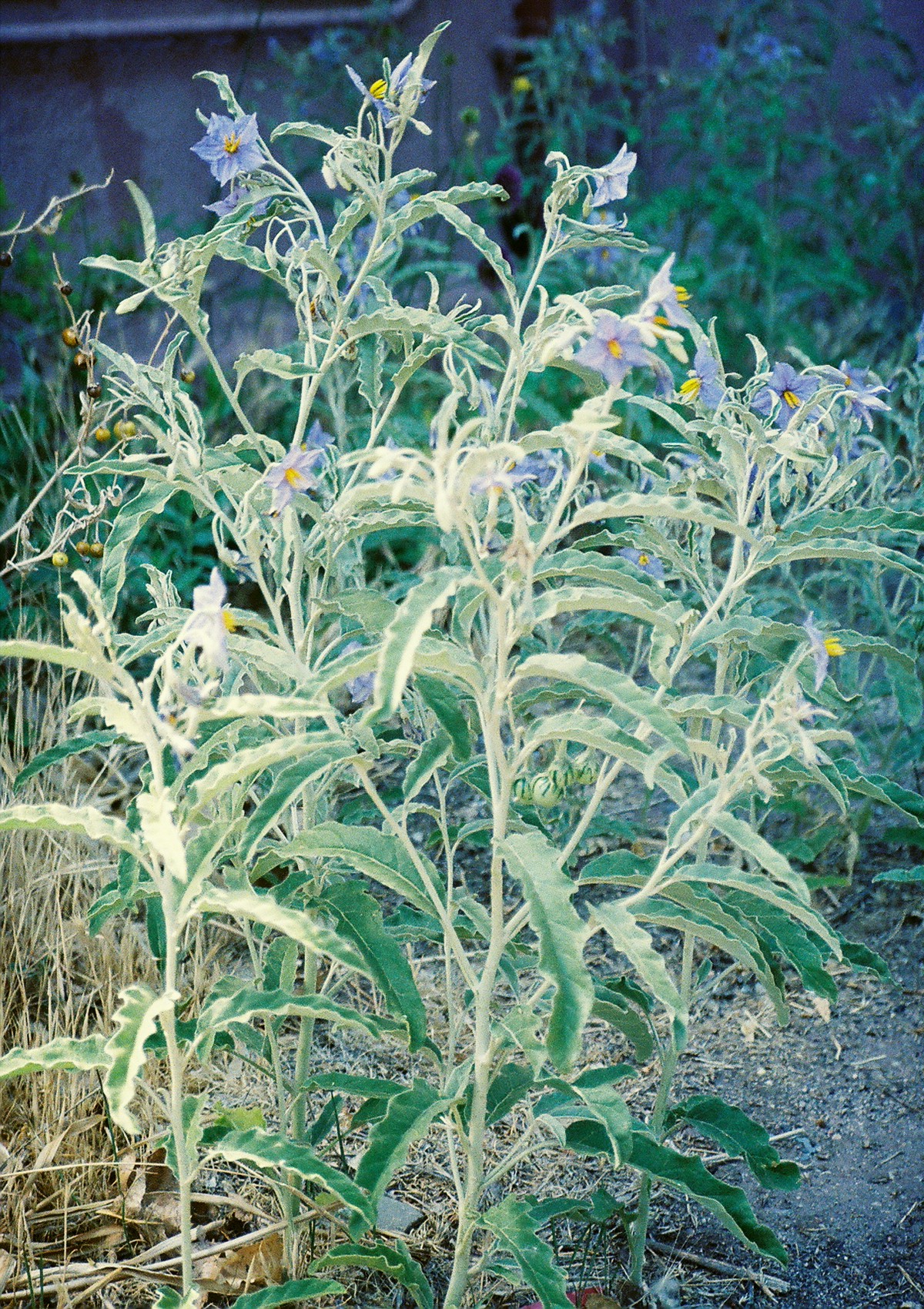- Solanum elaeagnifolium
:"This article is about the "Solanum elaeagnifolium" described by A. J. Cavanilles. The plant described under the same name by W. Herbert and C. L. Willdenow based on E.G. von Steudel is "S. aethiopicum.Taxobox
name = Silver-leaved Nightshade

image_width = 200px
image_caption = Plant with flowers, unripe berries (green with stripes, center), and previous year's berries (orange, upper left)
regnum =Plant ae
divisio =Magnoliophyta
classis =Magnoliopsida
subclassis =Asteridae
ordo =Solanales
familia =Solanaceae
genus = "Solanum "
species = "S. elaeagnifolium"
binomial = "Solanum elaeagnifolium"
binomial_authority = Cav.
synonyms =See textSilver-leaved Nightshade or Silverleaf nightshade, "Solanum elaeagnifolium", is a common
weed of westernNorth America and also found inSouth America . Other common names include Prairie Berry, Silverleaf Nettle, White Horsenettle or Silver Nightshade. InSouth Africa it is known as Silver-leaf bitter-apple or "satansbos" ("Satan 's Bush" inAfrikaans ). More ambiguous names include "bull-nettle ", "horsenettle " and the Spanish "trompillo "". [Cronquist "et al." (1984), USDA (2006)]Description and ecology
It is a perennial 10 cm [Niehaus "et al." (1984)] to 1 m in height. The stems are covered with short spines, ranging from very few on some plants to very dense on others. Leaves and stems are also covered with downy hairs that lie against and hide the surface, giving a silvery or grayish appearance.Cronquist "et al." (1984)]
The leaves are up to 15 cm long and usually only 0.5 to 2.5 cm wide, with shallowly waved edges. This is one of the marks distinguishing it from the closely related
Carolina Horsenettle ("S. carolinense"), which has wider, more deeply indented leaves. The flowers, appearing from April to August, have five petals united to form a star, ranging from blue to pale lavender or occasionally white; five yellowstamen s and apistil form a projecting center. The plant produces glossy yellow, orange, or red berries that last all winter and may turn brown as they dry.Its range is from
Kansas south toLouisiana , and west through the Mexican-border states of theUnited States intoMexico , as well asUruguay ,Argentina , andChile USDA (2006)] . Possibly it originated in North America and was accidentally introduced to South AmericaWSNWCB (2008)] or vice-versa. It can grow in poor soil with very little water. It spreads byrhizome s as well as seeds, and is common in disturbed habitats. Partly because of these characteristics, it is considered anoxious weed in 21 U.S. states and in countries such asAustralia ,Egypt ,Greece ,India ,Israel ,Italy ,South Africa , andZimbabwe [Nugent (2005), WSNWCB (2008)] . It is toxic to livestock and very hard to control, as rootstocks less than 1 cm long can regenerate into plants [CDFA [2008] ] . However, some gardeners encourage it as axeriscape ornamental.The
Pima Indians used the berries as a vegetablerennet , and theKiowa used the seeds together withbrain tissue to tanleather .ynonyms
This plant has been described under a range of names, all now invaild. These contain many
homonym s among them:Solanaceae Source [2008] ]
* "Solanum dealbatum" Lindl.
* "Solanum flavidum" Torr.
* "Solanum incanum" Pav. ex Dunal ("non" L.: preoccupied):"S. incanum" of Ruiz & Pavón Jiménez is "S. albidum" as decribed byDunal . :"S. incanum" ofKitaibel based on Kanitz is "S. villosum" as decribed byPhilip Miller :"S. incanum" of Scheff. is "S. schefferi".:"S. incanum" var. "lichtensteinii" and var. "subexarmatum" are "S. lichtensteinii".
* "Solanum leprosum" Ortega
* "Solanum obtusifolium" Dunal ("non" Willd.: preoccupied):"S. obtusifolium" of Hartweg based onOtto Sendtner in von Martius is "S. ferrugineum".:"S. obtusifolium" of Willdenow is "S. aethiopicum".
* "Solanum pyriforme var. uniflorum" Dunal
* "Solanum roemerianum" Scheele
* "Solanum saponaceum" Hook. ("non" Dunal: preoccupied):"S. saponaceum" of Welwitsch is "S. aculeastrum".:"S. saponaceum" var. "uruguense" is "S. bonariense".
* "Solanum texense" Engelm. & A.Gray
* "Solanum uniflorum" Meyen ex Nees ("non" Dunal: preoccupied):"S. uniflorum" of de Conceição Vellozo is "S. pseudocapsicum". :"S. uniflorum" of Sessé & Mociño and "S. uniflorum" of Dunal in Poiret have been identified as "Lycianthes mociniana ".:"S. uniflorum" of Lagasca y Segura and "Solanum uniflorum var. berterianum" are undetermined species of "Lycianthes ".Several varieties and forms of "S. elaeagnifolium" have been named. But therse days, they are not usually considered
taxonomical ly distinct anymore:
* "Solanum elaeagnifolium" f. "albiflorum" Cockerell
* "Solanum elaeagnifolium" var. "angustifolium" Kuntze:Not to be confused with "S. angustifolium" of Philip Miller
* "Solanum elaeagnifolium" var. "argyrocroton" Griseb.
* "Solanum elaeagnifolium" f. "benkei" Standl.
* "Solanum elaeagnifolium" var. "grandiflorum" Griseb.:Not to be confused with "S. grandiflorum" of Ruiz and Pavón Jiménez
* "Solanum elaeagnifolium" var. "leprosum" (Ortega) Dunal
* "Solanum elaeagnifolium" var. "obtusifolium" (Dunal) DunalHowever, "S. elaeagnifolium" var. "ovalifolium" does not refer to the "S. ovalifolium" as described by Dunal and does not belong to the present species; it is actually "S. aridum". Meanwhile, "S. crispum" var. "elaeagnifolium" is just the normal "S. crispum" of Ruiz and Pavón Jiménez.
Footnotes
References
* [2008] : Encycloweedia – [http://www.cdfa.ca.gov/phpps/ipc/weedinfo/solanum-americanum.htm "Solanum" part 2] . Retrieved 2008-SEP-26.
* (1984): "Intermountain Flora; Vascular Plants of the Intermountain West, U.S.A." (Vol. 4. Subclass Asteridae except Asteraceae). The New York Botanical Garden. ISBN 0-231-04120-9
* (1984): "A Field Guide to Southwestern and Texas Wildflowers". Houghton Mifflin Company, ISBN 0-395-36640-2
* (2005): Oregon Invasive Species Action Plan. [http://www.oregon.gov/OISC/docs/pdf/oisc_plan6_05.pdf PDF fulltext]
* [2008] : [http://www.nhm.ac.uk/research-curation/research/projects/solanaceaesource/taxonomy/description-detail.jsp?spnumber=2361 "Solanum elaeagnifolium"] . Retrieved 2008-SEP-26.
* (2006): Germplasm Resources Information Network - [http://www.ars-grin.gov/cgi-bin/npgs/html/taxon.pl?101507 "Solanum elaeagnifolium"] . Version of 2006-JAN-14. Retrieved 2008-SEP-26.
* (2008): [http://www.nwcb.wa.gov/weed_info/Solanum_elaeagnifolium.html Silverleaf Nightshade] . Version of 2008-JUL-09. Retrieved 2008-SEP-26.
Wikimedia Foundation. 2010.
